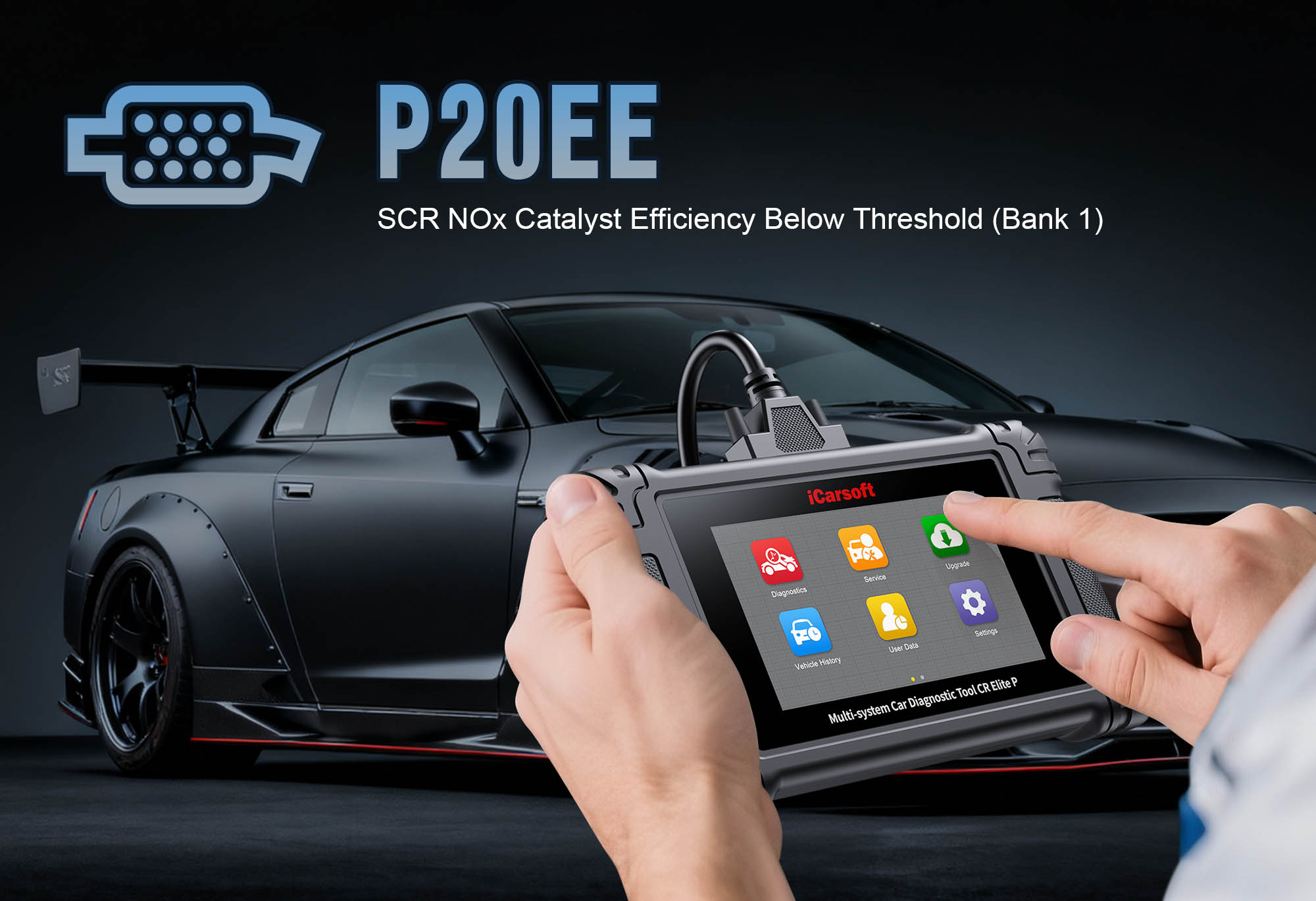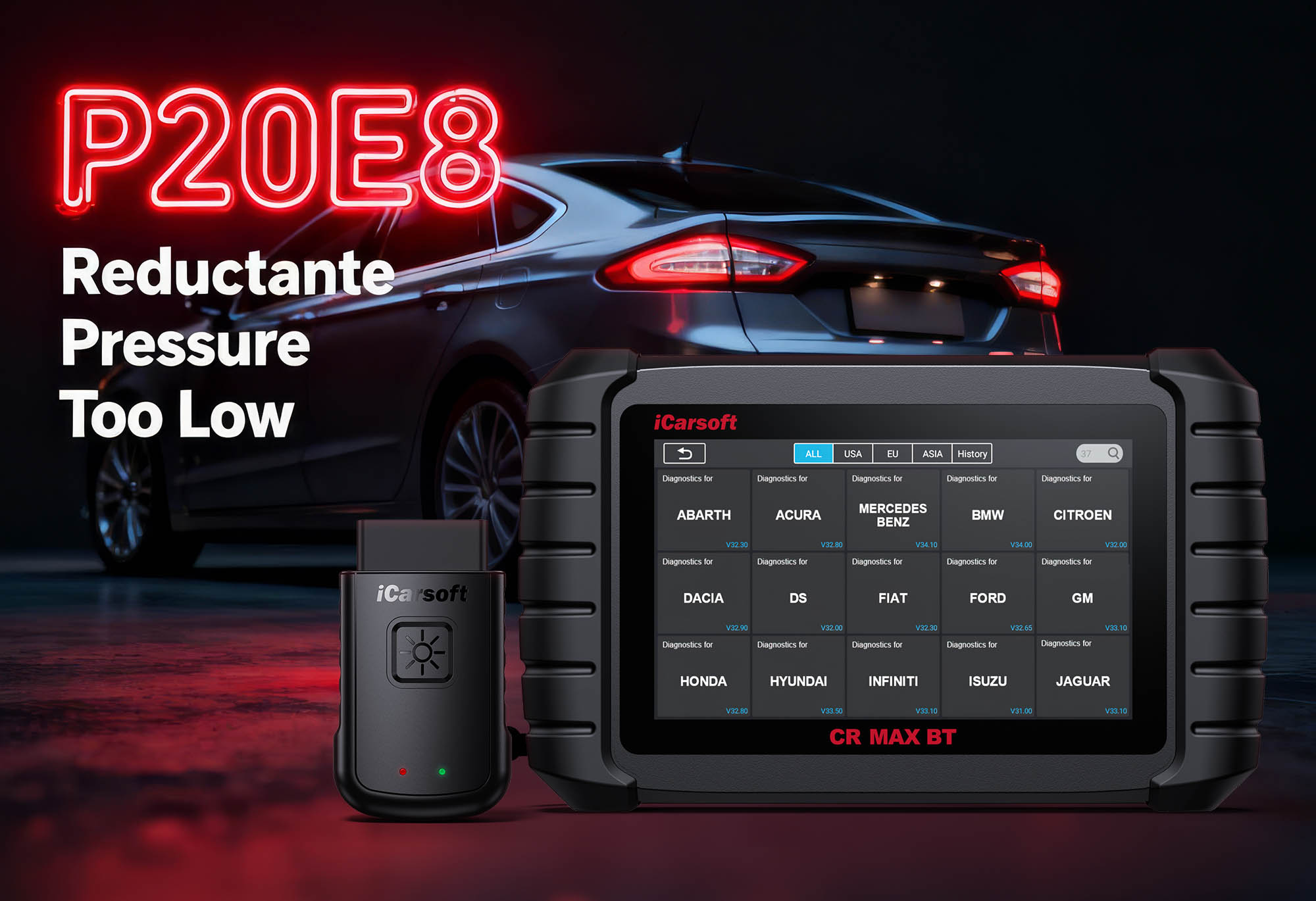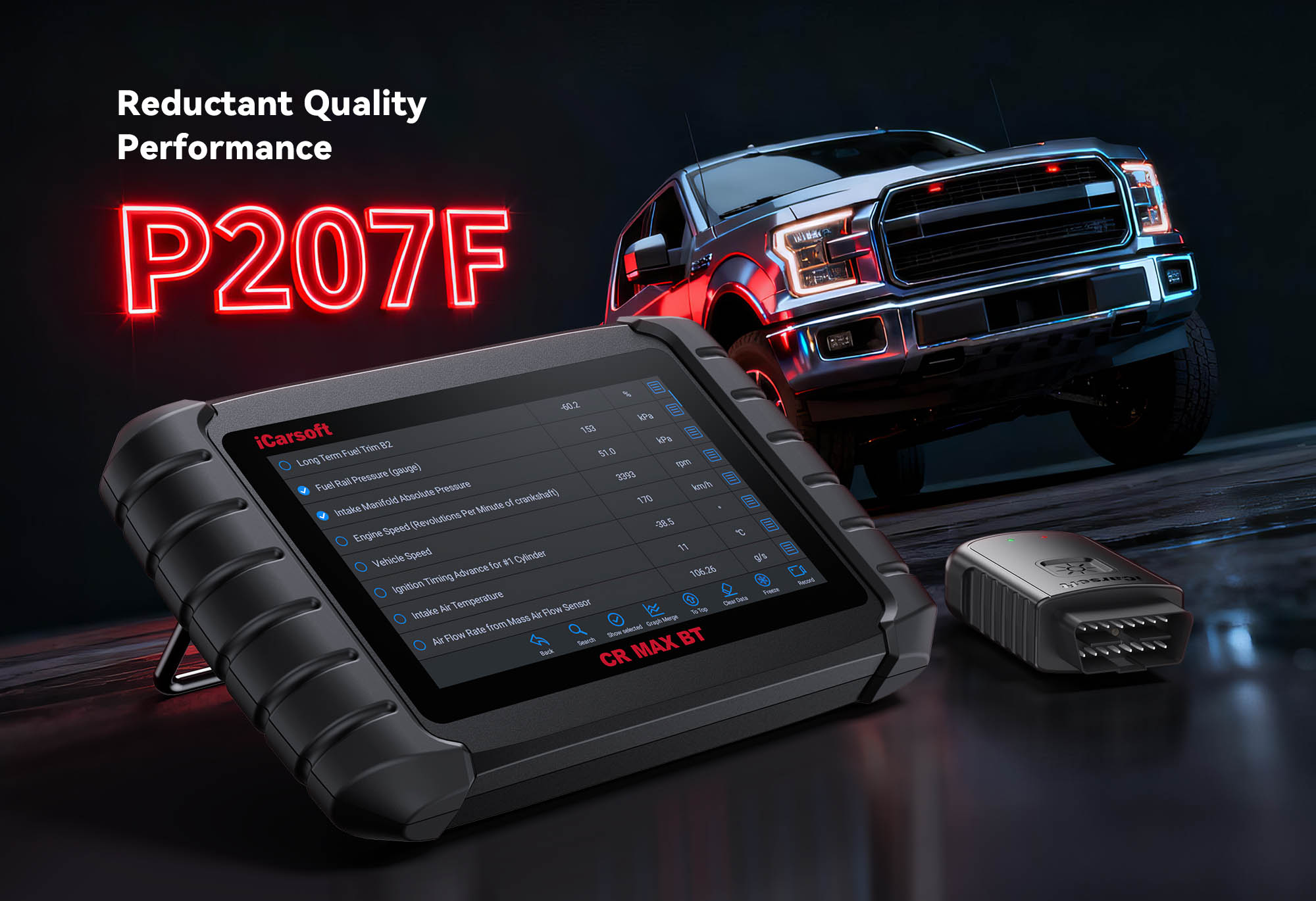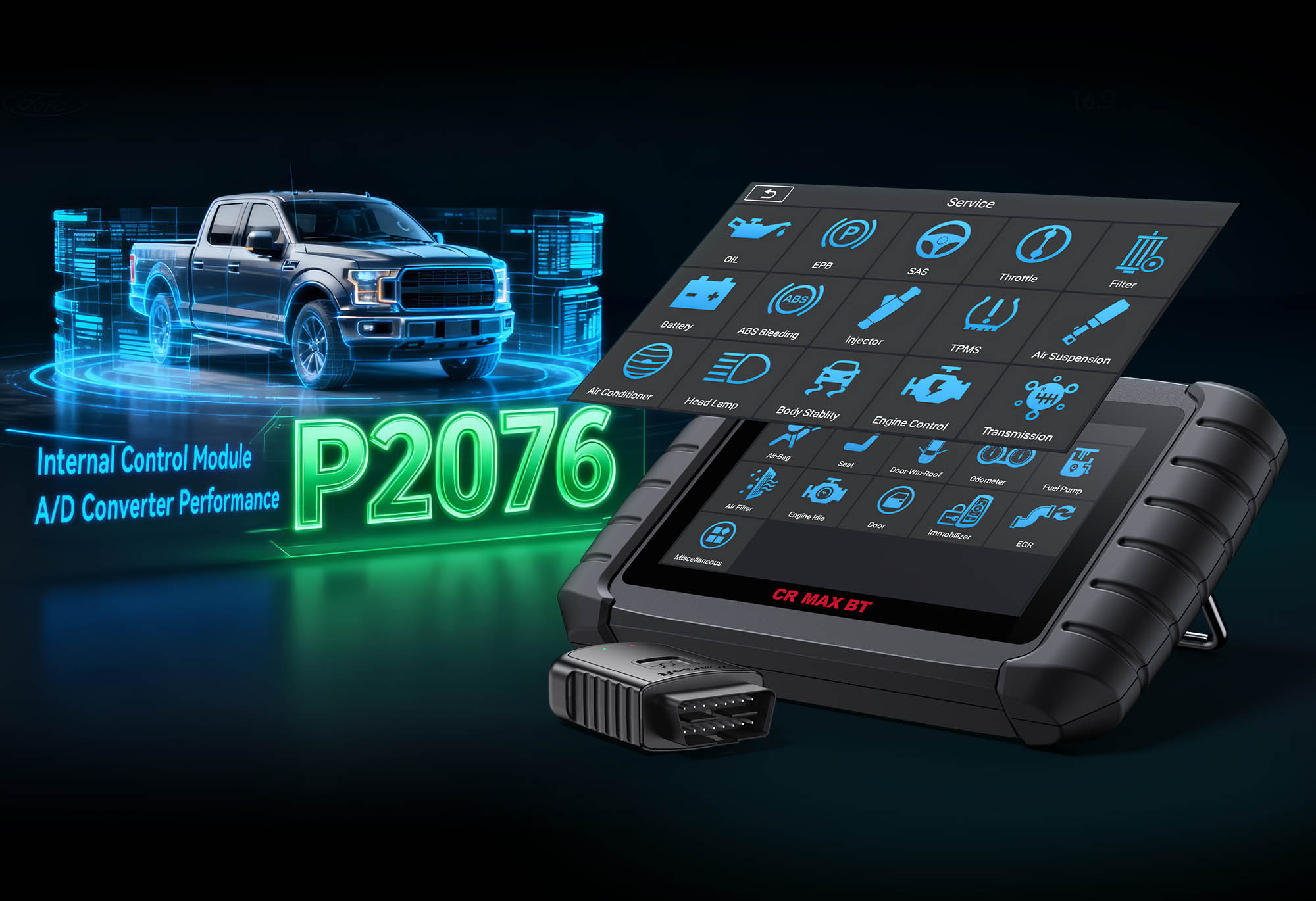Diagnose & Clear P20EE with iCarsoft CR Elite P: Fix SCR System Efficiency Below Threshold (Diesel Vehicles)
If your modern diesel vehicle’s check engine light illuminates, the "DEF Light" flashes, or you’re forced into "Limp Mode" with reduced power, a diagnostic scan will likely return P20EE. This OBD-II code stands for "Selective Catalytic Reduction (SCR) System Efficiency Below Threshold"—a critical fault indicating the SCR system (which reduces harmful nitrogen oxide (NOx) emissions using Diesel Exhaust Fluid (DEF)) is no longer meeting emissions standards. A failing SCR system not only risks costly fines for non-compliance but also triggers engine power limits to prevent further damage.
Basic scanners may only flag "SCR efficiency fault" but can’t monitor DEF levels, test NOx sensors, or verify urea injection—leaving you unable to distinguish between simple fixes (e.g., low DEF) and complex issues (e.g., failed SCR catalyst). The iCarsoft CR Elite P, with its specialized SCR/DEF diagnostics, NOx sensor validation, and urea injection tests, solves this. Let’s break down how to diagnose and resolve P20EE with precision, leveraging the CR Elite P’s unique capabilities to restore emissions compliance and engine performance.
Understanding P20EE: Causes & Key Symptoms
The SCR system relies on DEF (a urea-based fluid) to convert NOx into harmless nitrogen and water—P20EE occurs when the ECM detects the system isn’t reducing NOx enough. Symptoms worsen as NOx levels rise, prompting the ECM to activate protective measures:
Key Symptoms of P20EE
-
Check Engine Light (CEL) + DEF Warning Light: The CEL triggers for P20EE, while the DEF light (often blue or amber) flashes to signal low DEF, DEF quality issues, or SCR failure.
-
Limp Mode Activation: To meet emissions laws, the ECM limits speed to 30–40 mph and power to 50%—stranding you if ignored.
-
Increased DEF Consumption: A faulty SCR system may burn DEF faster than normal (e.g., 1 gallon per 50 miles instead of 1 gallon per 200 miles).
-
NOx Emissions Warning: Some vehicles display a "High NOx" message on the dashboard—indicating the SCR catalyst isn’t working.
-
Engine Hesitation: Reduced power from limp mode causes sluggish acceleration, making highway merging or hill climbing nearly impossible.
-
Failed Emissions Tests: Excess NOx levels guarantee a failed state inspection—critical for vehicle registration.
Common Causes of P20EE
|
Cause
|
Description
|
|
Low or Contaminated DEF
|
Running out of DEF or using non-compliant fluid (e.g., watered-down urea) disrupts NOx conversion—DEF must meet ISO 22241 standards.
|
|
Clogged DEF Injector
|
Urea crystals (from DEF freezing or aging) clog the injector, preventing DEF from spraying into the exhaust.
|
|
Faulty NOx Sensors
|
The SCR system uses 2–3 NOx sensors (before/after the catalyst) to measure efficiency—failed sensors send incorrect data to the ECM, triggering P20EE.
|
|
Damaged SCR Catalyst
|
Physical damage (e.g., road debris) or thermal shock (sudden temperature changes) breaks the catalyst’s internal structure, reducing NOx conversion.
|
|
DEF Quality Sensor Failure
|
A faulty sensor incorrectly reports "bad DEF" (even if fluid is good), causing the ECM to disable the SCR system.
|
|
Clogged DEF Tank Filter
|
Dirt or debris in the DEF tank clogs the filter, restricting fluid flow to the injector.
|
Why iCarsoft CR Elite P Excels at Diagnosing P20EE
The CR Elite P outperforms basic tools with features tailored to diesel SCR/DEF systems—critical for resolving P20EE:
Live DEF System Monitoring
Tracks DEF level (%), DEF temperature, urea concentration, and injector duty cycle—identifies low fluid or contamination.
NOx Sensor Validation
Tests pre- and post-catalyst NOx sensors (measures NOx levels in ppm) to confirm if they’re accurately detecting emissions.
DEF Injector Tests
Performs bi-directional tests to activate the injector, verifying if it sprays DEF correctly (rules out clogs or electrical faults).
SCR Catalyst Efficiency Calculations
Compares pre- and post-catalyst NOx levels to calculate conversion efficiency—values <80% confirm a faulty catalyst.
AutoVIN Identify
Automatically retrieves your diesel vehicle’s make, model, and SCR configuration in seconds, ensuring access to vehicle-specific specs.
Global Diesel Coverage
Works with 500+ diesel models (light-duty trucks, SUVs, vans) from Ford, Chevrolet, Ram, Toyota, Volkswagen—supports 2010+ EPA-compliant SCR systems.
DEF Quality Checks
Verifies urea concentration (should be 32.5%) via the vehicle’s DEF quality sensor—alerts you to contaminated fluid.
Step-by-Step: Diagnose P20EE with iCarsoft CR Elite P
-
1. Check DEF Level & Quality (First, Cheapest Fix)
Low or bad DEF is the #1 cause of P20EE—start here to avoid unnecessary repairs:
1. DEF Level Check: Navigate to Engine > Live Data > SCR/DEF System > DEF Level—levels below 20% trigger P20EE in most vehicles. Add ISO 22241-compliant DEF to the blue-capped fill port (use Component Location > SCR/DEF > DEF Tank for position).
2. DEF Quality Check: Select SCR/DEF System > DEF Quality—urea concentration should read 32.5%. Values <30% or >35% = contaminated fluid. Drain the tank and refill with fresh DEF (follow the tool’s DEF Drain Procedure).
-
2. Connect the CR Elite P & Confirm P20EE
1. Plug the CR Elite P into your vehicle’s OBD-II port (use adaptors for older OBDI diesels). Power on and select AutoVIN Identify to detect SCR system type.
2. Navigate to Engine > Fault Codes > Read Codes to confirm P20EE. Tap Code Details for vehicle-specific insights (e.g., "Ram 2500: SCR Efficiency 66% < 80%; Check NOx Sensors").
3. Resolve related codes (e.g., P202E, P203F) first—they directly cause P20EE.
-
3. Test NOx Sensors (Pre- & Post-Catalyst)
Faulty NOx sensors send false efficiency data—validate their accuracy:
1. Locate Sensors: Use Component Location > SCR/DEF > NOx Sensors—most systems have Sensor 1 (before SCR catalyst) and Sensor 2 (after SCR catalyst).
2. Live NOx Level Test: Start the engine, idle 10 minutes (warm SCR system). Navigate to SCR/DEF System > NOx Levels—normal efficiency means post-catalyst NOx <20% of pre-catalyst levels (e.g., pre: 1,000 ppm → post: <200 ppm).
3. Sensor Response Test: Select Special Functions > SCR/DEF > NOx Sensor Response—good sensors change readings within 5 seconds; bad sensors show no change (replace).
-
4. Inspect & Test the DEF Injector
A clogged injector prevents DEF from reaching the SCR catalyst—test for issues:
1. Visual Inspection: Locate the injector (on exhaust pipe before SCR catalyst via component mapping). Check for white urea crystals around the tip.
2. Bi-Directional Injector Test: Engine off, ignition "ON." Navigate to Special Functions > SCR/DEF > DEF Injector Activation. Command 10%/50% duty cycle—listen for a "hissing" sound (indicates flow). No sound = clean the injector (soak in warm DEF 15 mins) or replace.
3. Injector Circuit Test: Use the tool’s multimeter—power wire should show 12V (ignition "ON"); signal wire fluctuates 0–5V when activated. No voltage = blown fuse (check Fuse Guide).
-
5. Check SCR Catalyst Efficiency
If DEF and sensors are good, the catalyst may be damaged—calculate efficiency:
1. Start the engine and drive 50 mph for 10 minutes (fully warm the SCR system).
2. Navigate to SCR/DEF System > SCR Catalyst Efficiency—the tool compares pre- and post-catalyst NOx levels.
3. Good Catalyst: Efficiency >80%. Bad Catalyst: Efficiency <80% (replace with EPA-compliant OEM/aftermarket unit; use Part Lookup for compatibility).
4. Visual Inspection: Check the catalyst for dents, cracks, or oil leaks—oil contamination destroys the catalyst.
-
6. Test the DEF Quality Sensor
A faulty quality sensor incorrectly reports bad DEF—verify functionality:
1. Navigate to SCR/DEF System > DEF Quality Sensor Test on the CR Elite P.
2. The tool compares the sensor’s reading to fresh DEF (32.5%). Good sensors read 32.0–33.0%; bad sensors read <30% or >35% (replace the sensor, located in the DEF tank).
-
7. Repair & Clear P20EE
Fix the Root Cause (based on diagnostics):
- Low/Contaminated DEF: Refill with fresh ISO 22241 DEF.
- Clogged DEF Injector: Clean or replace (match OEM parts via Part Lookup).
- Faulty NOx Sensor: Replace the sensor (torque to 25–30 Nm) and reset sensor learning via the tool.
- Damaged SCR Catalyst: Replace with EPA-compliant catalyst.
- Faulty DEF Quality Sensor: Replace the sensor and refill DEF.
Clear the Code: Navigate to Engine > Fault Codes > Clear Codes. Reset Limp Mode (if active) via Special Functions > Engine > Limp Mode Reset.
-
8. Validate the Repair
Ensure the SCR system works correctly and P20EE doesn’t return:
1. Start the engine—no CEL, DEF light, or limp mode should activate.
2. Test drive 50+ miles (highway speeds to warm SCR system):
- DEF consumption is normal (1 gallon per 150–250 miles).
- No power loss or hesitation.
3. Post-Repair Data Check: Use SCR/DEF System live data to confirm: DEF level >20%, urea concentration = 32.5%, SCR efficiency >80%.
4. Run the I/M Readiness Test (under OBDII Functions) for emissions compliance.
Preventing P20EE Recurrence
The CR Elite P helps maintain SCR/DEF system health to avoid future issues:
-
DEF Maintenance: Use the tool’s Service Reminder to check DEF level every 1,000 miles—never let it drop below 10%. Store DEF in a cool, dry place (freezes at 12°F/-11°C but thaws without damage).
-
NOx Sensor Checks: Schedule tests every 60,000 miles—replace sensors every 100,000 miles (per manufacturer recommendations) to prevent false P20EE codes.
-
DEF Injector Cleaning: Use the DEF Injector Cleaning Reminder to clean the injector every 30,000 miles (use DEF system cleaner like Liqui Moly DEF System Cleaner).
-
SCR Catalyst Protection: Avoid short trips (less than 10 minutes)—they prevent the SCR system from reaching operating temperature, leading to urea crystal buildup.
Conclusion
P20EE’s SCR efficiency fault is a compliance and performance crisis for diesel owners, but the iCarsoft CR Elite P simplifies diagnosis with DEF monitoring, NOx sensor tests, and injector validation. Whether refilling DEF, cleaning an injector, or replacing a sensor, this tool ensures you address the root cause—saving you from expensive dealer visits and emissions fines.
For DIY diesel enthusiasts and professionals alike, the CR Elite P’s SCR-specific features, global coverage, and intuitive interface make it the ideal tool for resolving P20EE. Restore emissions compliance, regain full engine power, and keep your diesel vehicle road-legal—all with one professional-grade diagnostic tool.
FAQs About P20EE Code
Q: Can I drive with P20EE?
A: Only short distances (to a repair shop) are safe. Prolonged driving activates limp mode and risks SCR catalyst damage—fix P20EE within 50 miles to avoid costly repairs or emissions fines.
Q: How much does it cost to fix P20EE?
A: Costs range from $10–$30 for DEF refills, $150–$400 for NOx sensors, $200–$500 for DEF injectors, and $800–$2,500 for SCR catalyst replacement (parts + labor). The CR Elite P saves money by avoiding misdiagnoses.
Q: Why does P20EE return after refilling DEF?
A: Unaddressed issues—e.g., a clogged DEF injector, faulty NOx sensor, or contaminated DEF tank. Use the CR Elite P’s live data to test injector flow and NOx sensor accuracy post-refill.
Q: Is it legal to bypass the SCR system to fix P20EE?
A: No—federal emissions laws (EPA Clean Air Act) prohibit SCR bypass. Bypassing leads to fines up to $4,829 per violation and invalidates vehicle warranties. Always repair the SCR system with compliant parts.





